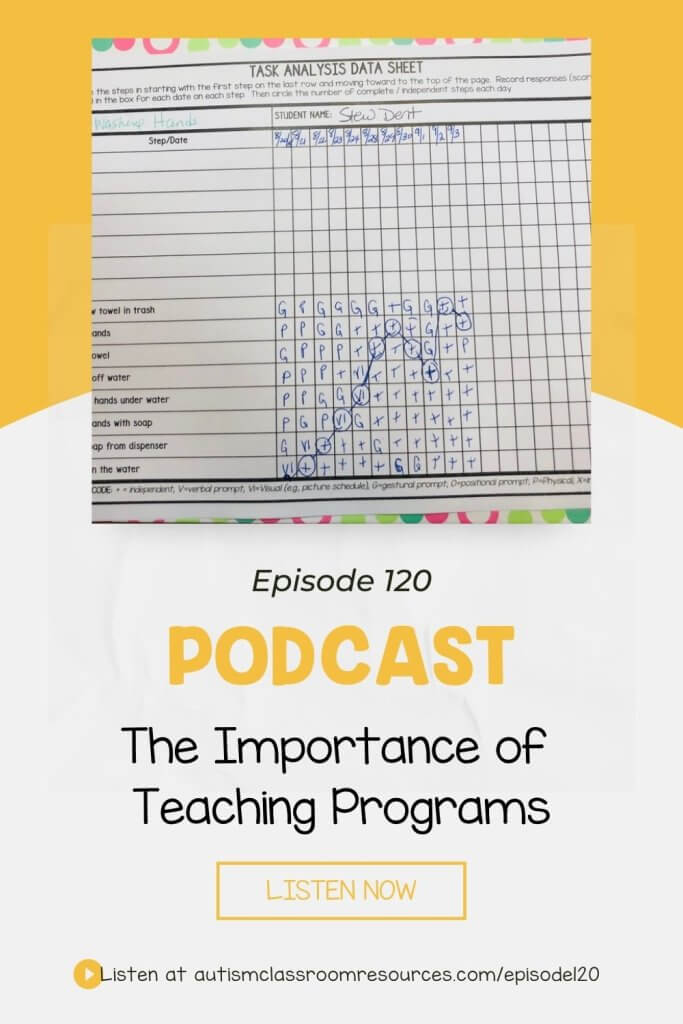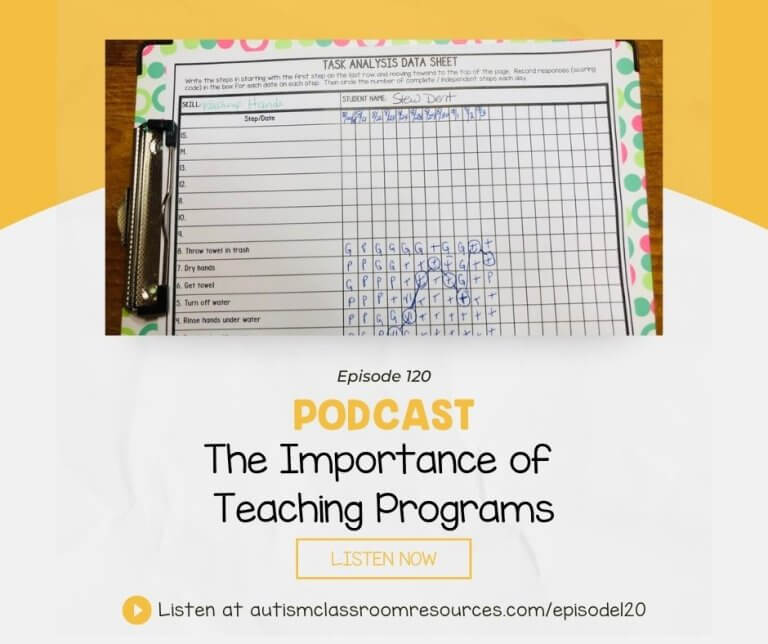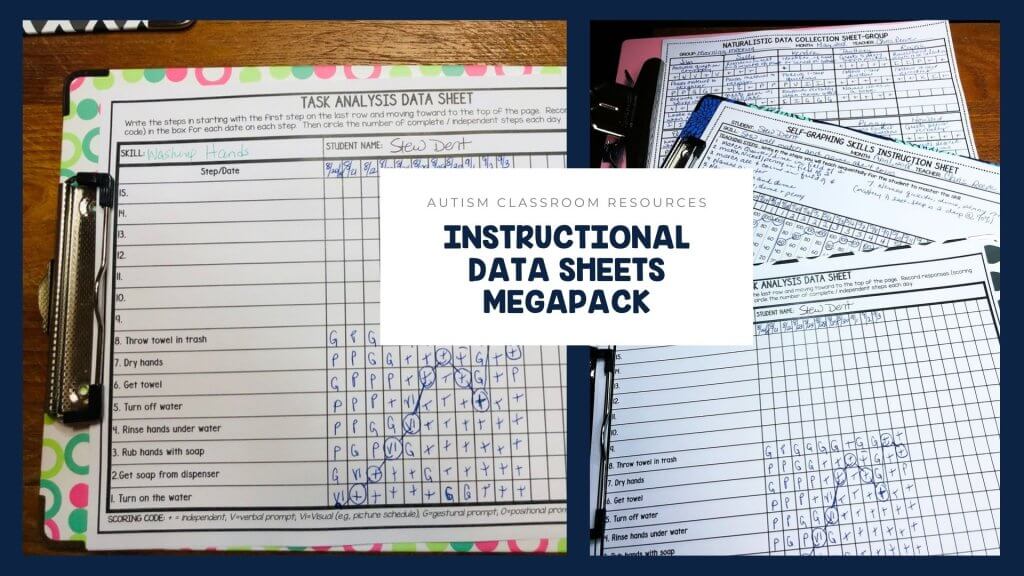Welcome to the Autism Classroom Resources Podcast, the podcast for special educators who are looking for personal and professional development.
Christine Reeve: I’m your host, Dr. Christine Reeve. For more than 20 years, I’ve worn lots of hats in special education but my real love is helping special educators like you. This podcast will give you tips and ways to implement research-based practices in a practical way in your classroom to make your job easier and more effective.
Welcome back. This is the Autism Classroom Resources Podcast and I’m Christine Reeve. Hello. I am so glad that you are joining me today. We are on a journey talking all about ABA instruction this month and this is our last session in that. This week I’m going to be talking about teaching programs. I’ll be talking about what they are and why they’re important. I’m going to share a tip that will really boost your students’ learning and your instruction across the classroom.
Now if you’re looking for tips like these on how to make your students’ instruction more effective and efficient, keep listening. If you are just getting started working with ABA strategies or you want more tips on how to make your instruction more effective, come check out the Special Educator Academy. We have workshops, a private podcast, and five-minute lightning trainings that you can grab really quickly for improving your effectiveness as a teacher as well as lowering your stress level at the same time.
SEA is not an ABA based program, and it’s designed for teachers of students with all special ed needs. But if you’re working with students with autism or working with ABA instruction, that definitely is a good fit to support you and make your life easier. We even have live office hours every week where you can access me and our amazing community for questions. So come grab your free seven-day trial at specialeducatoracademy.com. As one member said, “Join, it’s good for the soul.” Now, let’s get started.
Let’s start by talking about what teaching programs are. Teaching programs are the actual steps that you use to teach a skill. For some of our skills, those programs are built into curriculum. For instance, if you’re using the Edmark Reading series, you follow a set of specific directions to tell the students to move down the page pointing to the word and reading the word. The directions are built into the curriculum itself and they’re pretty scripted. In other curricula, we aren’t told specifically what to say. In other words, it’s not scripted, but the steps we have to present the skills in, sometimes we call that scaffolding of the skill, is the way the curriculum is set up. The teaching program is still built into the curriculum.
But for some of our students, we’re teaching kind of off the standard curriculum. We’re even teaching a bit off the adapted curriculum for some of our students. That means that we’re developing or pulling, from multiple resources, specific teaching programs for their skills. This is most clear when we talk about teaching skills using task analyses. Everybody’s heard of task analysis. A task analysis is basically just a breakdown of the steps for teaching a skill. It can be a shaping task analysis where each step replaces the one before. First, he stays in an activity for one minute, and then two minutes, and then five minutes and then eight minutes. Or they can be sequential steps. Like when we’re washing our hands, first we turn on the water, then we get our hands wet, then we get the soap. I can’t get my hands wet if I haven’t turned on the water first. We can’t do the next step until we do the step before it.
This is often called a chaining task analysis because the behavior happens in a chain and we use what’s called forward or backward chaining teaching strategies or total test teaching strategies to help teach it. Now, the chaining teaching strategies are actually a great way to teach more efficiently. I’ve got some posts about that that I’ll make sure are in the show notes so that you can learn more about them there. If there’s an interest, I will be happy to do a podcast about them in future.
A teaching program is simply the steps that you’re using to teach the task and the steps the student has to take to perform the task. Usually it’s a combination of those two. Having a specific teaching program is important because our students in special ed need more consistency in their instruction. They are not one trial learners, and they usually don’t learn things when they’re presented in different ways each time. They learn best through repetition and practice following the same procedures each time that consistency is so important for our students. Because of that, it’s critical that we have teaching programs for all of our skills that we’re specifically trying to teach.
For instance, I’m willing to bet if you ask parents, paraprofessionals, or even your significant other how they brush their teeth, you’re going to find some variation in the order of steps. Your significant other doesn’t put the cap on the toothpaste. You run the water while brushing your teeth and your paraprofessional turns it off. You have a parent who uses a Waterpik toothbrush which completely changes the order of the steps. In fact, this is actually exactly what happens when I do training on task analyses. I have groups work together and one of the things I have them do is make a task analysis of a peanut butter sandwich. It’s a fascinating exercise, because every group gets into these large discussions about what steps need to go into it.
I make peanut butter sandwiches at least two to three times a week. It’s not a hard task. After they have that big discussion among themselves, they make their steps. But every single group has a different set of steps when they’re done. Now, I want to imagine that the educators in those groups are teaching a student with disabilities in their class, how to make a peanut butter sandwich. One staff member walks them through the task of putting peanut butter on both sides, both pieces of the bread and cuts the sandwich in half. Another has them put peanut butter on only one piece of bread and cuts the sandwich in triangles, and another puts jelly on the sandwich in addition to peanut butter, which is usually the first question I get asked when I ask people to do this, “Is it a peanut butter and jelly sandwich?” I don’t know. You tell me.
Imagine how confused that student is going to be when we just tell him to go make a peanut butter sandwich on his own. How does he know which person’s peanut butter sandwich he should make? I want to talk about some of the reasons why having a written teaching program is so important for our special ed classroom based on all of that information. First, having consistent steps that are followed each time the skill is taught is going to increase the efficiency of the students’ learning. Change up the steps too much and the student is going to take way longer to learn that particular skill.
Second, having a written set of steps assures that you can and that you have tailored it to meet the needs of that specific student because one task analysis probably may not meet the needs for every student in your class. For instance, for Max, I need to have him start by participating in a group activity for five minutes. Then he’ll be ready to jump to 10 minutes after that. But if I did that same breakdown with Dolly, she’s never going to make progress on the skill because right now she can’t even sit for a minute. She’s never going to reach the reinforcer for five minutes if I start there, and once she gets to five minutes, jumping to 10 minutes is too big a jump. She needs us to start maybe at two minutes and go up two minutes at a time. But if we only have one task analysis, and we run everybody by the same task analysis for participating in groups, no one knows how we’re individualizing, maybe you’ve decided how you’re individualizing but your staff doesn’t necessarily know that.
Third, by not writing down the steps of the teaching program and having it available where the staff can see it either through a visual schedule, on a data sheet, or just a list of steps posted in the area, we’re likely to have staff who complete the steps in different order, or do completely different steps like our peanut butter sandwich example. That’s going to be very confusing to the student. The staff isn’t necessarily even going to realize that they’re doing something different than everybody else.
Finally, a really important reason for having a written set of steps for the teaching program and assuring that they’re accessible in the area is to make sure that we’re taking data on them, and because when we take our data on them, they allow us to demonstrate progress step by step. In fact, one of the really great things about task analysis is that because the steps are broken down into those small components, it’s much easier to show progress for our students who make very slow progress. We can show that they mastered a percentage of the steps, even if they didn’t master the whole skill. For some of our students, that’s significant progress.
For Dali to master sitting in a morning meeting for 5 minutes is probably the same level of accomplishment as Matt learning to sit for 20. Their individualized task analysis allows us to show that in their data. Those are some of the simple ways that having a written teaching program can help you organize your instruction. Make sure all your staff is on the same page and take meaningful data to demonstrate even small steps of progress for your students effectively. I’ll share a link to my intervention data sheets that have a teaching program data sheet you can fill in with the steps of a task analysis and then take data on and graph it as you go so you can see the progress that the student is making, so you can make decisions about how to proceed.
If you’re looking for ways to expand those teaching strategies, you’re looking for task analyses, we actually have a set of task analyses on these data sheets as part of the Special Educator Academy. Come grab your seven-day free trial there at specialeducatoracademy.com.
Thank you so much for joining me today and for this month of this series on instructional practices. I hope that you’ll come back next week when we have a new topic when I’ll be talking about one of my favorite, favorite topics: communication and behavior, and how we improve them both. Until then, have an amazing week.









